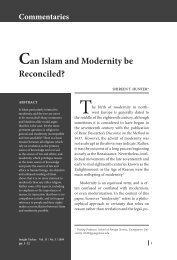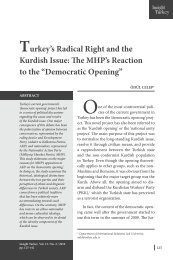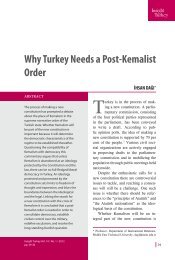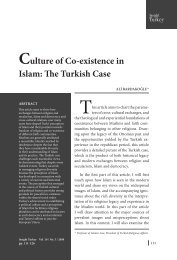Black Turks, White Turks: On the Three ... - Insight Turkey
Black Turks, White Turks: On the Three ... - Insight Turkey
Black Turks, White Turks: On the Three ... - Insight Turkey
You also want an ePaper? Increase the reach of your titles
YUMPU automatically turns print PDFs into web optimized ePapers that Google loves.
MÜCAHİT BİLİCİ<br />
that a Turk is a citizen of <strong>the</strong> Turkish Republic (as <strong>the</strong>y have been taught). But<br />
what if you ask who is <strong>the</strong> ideal citizen of <strong>Turkey</strong>? Whom does <strong>the</strong> state cherish<br />
as its preferred subject? What if you ask <strong>the</strong> average shopkeeper, schoolteacher, or<br />
police officer, what image first pops into <strong>the</strong>ir heads? I argue that <strong>the</strong>re are three<br />
components of Turkish national identity: Muslimness, Turkishness and secularism.<br />
This three-layered definition of Turkish national identity excludes a number<br />
of groups. Some of <strong>the</strong>se exclusions are visible and recognized while o<strong>the</strong>rs are<br />
invisible and in need of recognition. Any group that fails to meet all three requirements<br />
fails to achieve full citizenship. They remain ei<strong>the</strong>r externally attached to<br />
<strong>the</strong> nation (as <strong>the</strong> Greeks, Armenians and Jews are) or relegated to o<strong>the</strong>r times<br />
and places (on <strong>the</strong> mountains in <strong>the</strong> case of <strong>the</strong> Kurds, or in <strong>the</strong> past in <strong>the</strong> case<br />
of religious people).<br />
The Turkish Republic was built on <strong>the</strong> political, cultural and psychological debris<br />
of <strong>the</strong> Ottoman Empire. Culturally it was extremely heterogeneous—an undesirable<br />
condition for <strong>the</strong> taste of modern nation builders. Psychologically it was<br />
just coming out of trauma caused by prolonged wars and a sense of having been<br />
besieged by non-Muslim great powers. The Ottoman Empire lost <strong>the</strong> majority of<br />
its territory (85 percent) and population (75 percent) in <strong>the</strong> last 50 years of its history.<br />
It would also be fur<strong>the</strong>r homogenized through <strong>the</strong> massacre of Armenians<br />
in 1915 and <strong>the</strong> population exchange with Greece in 1923. In <strong>the</strong> late period of its<br />
history, <strong>the</strong> Ottoman state was also engaged in building a nation based on Muslim<br />
identity. A path-dependency initiated by <strong>the</strong> Ottoman millet system and deepened<br />
by Sultan Abdulhamid II’s policy of constructing a “Muslim nation” became<br />
<strong>the</strong> main legacy upon which <strong>the</strong> young Turkish Republic would construct its own<br />
national identity.<br />
The political and cultural elite that exercised power in defining <strong>the</strong> new nation<br />
and its identity were mostly elite immigrants or of immigrant backgrounds,<br />
originally from <strong>the</strong> Balkans and <strong>the</strong> Caucasus. Ironically, for <strong>the</strong> most part <strong>the</strong>y<br />
were not ethnic <strong>Turks</strong>. They were Macedonians, Circassians, Georgians, Bosnians<br />
and Tatars. They were people whose history was shaped by persecution by non-<br />
Muslims on <strong>the</strong> ever-shrinking frontiers of <strong>the</strong> Ottoman Empire. Their strong<br />
attachment to Muslim identity was not necessarily religious but identity-related,<br />
for <strong>the</strong>ir Islamic identity was <strong>the</strong> single most important cause of <strong>the</strong>ir displacement<br />
and became <strong>the</strong> future avenue of <strong>the</strong>ir relocation within <strong>the</strong> remainder of<br />
<strong>the</strong> empire. They were, more often than not, non-Turkish Muslims for whom<br />
Muslimness and Turkishness were one and same thing. They were also more urbanized,<br />
Westernized and secular than <strong>the</strong> local population of Anatolia, who were<br />
26







